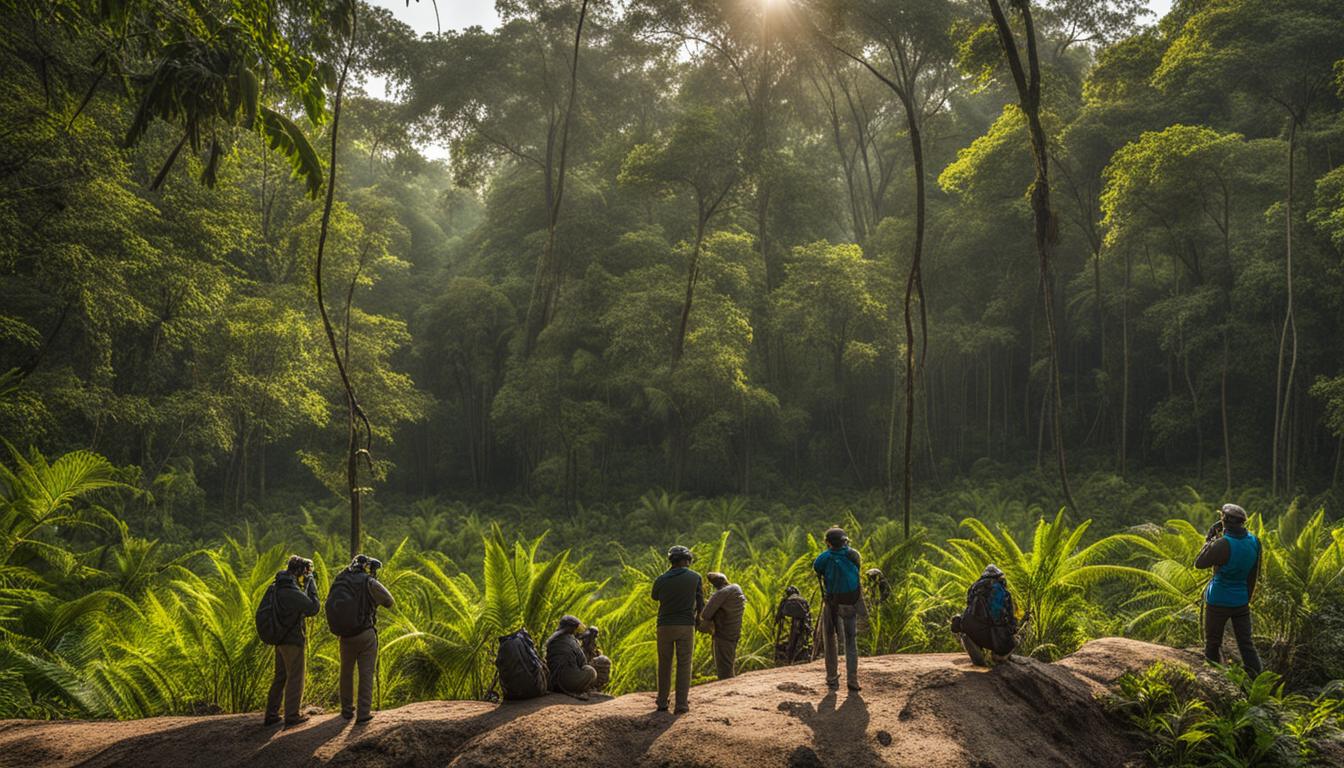If you’ve ever wondered how researchers track and study wild tiger populations, you’re in the right place. Understanding these majestic creatures and their behavior is crucial for their conservation efforts. In this article, we’ll explore the various techniques researchers use, the impact of tracking on wildlife conservation, and the role of tiger tracking in understanding environmental changes.
Key Takeaways:
- Tiger tracking and study are essential for tiger conservation efforts.
- Researchers use techniques like banding, tagging, radio and satellite tagging, and camera trapping.
- Behavior analysis helps in understanding habitat preferences and population dynamics.
- Advancements in wildlife tracking technology have revolutionized the way researchers monitor tiger populations.
- Protecting and conserving tiger habitats is crucial for the long-term survival of these magnificent animals.
Tiger Behavior Analysis
Understanding the behavior of tigers is crucial for effective conservation efforts. By analyzing tiger behavior, researchers can gain insights into their habitat preferences and population dynamics. Through a combination of field observations and data analysis, scientists can track the movements of individual tigers and map their habitat preferences.
Tracking and studying tiger behavior involves monitoring mating rituals, hunting techniques, and social interactions. This knowledge helps in developing evidence-based conservation strategies that prioritize habitat conservation and restoration efforts. By preserving and restoring tiger habitats, we can ensure that these magnificent creatures have the space and resources they need to thrive.
“Studying tiger behavior is like peering into a secret world,” says Dr. Lisa Johnson, a leading tiger behavior expert. “It allows us to understand their needs and design targeted conservation interventions. By analyzing their behavior, we can unlock valuable insights and make a meaningful difference in their survival.”
Tiger Habitat Mapping
Habitat mapping is an essential component of tiger behavior analysis. By mapping tiger habitats, researchers can identify critical areas for tiger survival and reproduction. This information guides conservation efforts, such as establishing protected areas and implementing sustainable land use practices.
Habitat mapping involves collecting data on vegetation types, prey availability, and other environmental factors that influence tiger behavior. Using advanced technology like satellite imagery and Geographic Information Systems (GIS), researchers can create detailed maps that highlight key tiger habitats. These maps help in identifying corridors that connect different habitats, allowing tigers to move freely across their range.
| Tiger Habitat Mapping | Benefits |
|---|---|
| Identifies critical areas for tiger survival and reproduction | Guides conservation efforts |
| Highlights key tiger habitats | Helps in identifying habitat corridors |
| Provides data on vegetation types and prey availability | Aids in sustainable land use planning |
Tiger habitat mapping plays a vital role in ensuring the long-term survival of these majestic animals and the preservation of healthy ecosystems. By understanding their habitat needs, we can protect and restore the areas that are crucial for tiger populations to thrive.
Wildlife Tracking Technology: A Game-Changer in Tiger Conservation
Advancements in wildlife tracking technology have revolutionized the way researchers monitor and study wild tiger populations. These cutting-edge tools provide invaluable insights into tiger behavior, habitat preferences, and population dynamics, which in turn inform effective conservation strategies. By employing radio and satellite tagging, researchers are able to collect highly detailed data on individual tigers, including their movements, feeding and breeding locations, and preferred habitats. This information helps conservationists understand the specific needs of tigers and tailor conservation efforts accordingly.
One of the key technologies utilized in tiger tracking is camera trapping. By setting up automated cameras in strategic locations, researchers can capture images of tigers in their natural habitats. These images allow for the identification of individual tigers and estimation of population sizes. With the help of computer vision algorithms, researchers can analyze these images to gather additional information about tiger behavior, such as hunting techniques and social interactions. This data aids in monitoring changes in tiger populations over time and implementing targeted conservation measures.
Advantages of Wildlife Tracking Technology in Tiger Conservation
- Accurate monitoring of tiger populations in specific areas
- Identification of individual tigers for population estimation
- Insights into tiger behavior and habitat preferences
- Development of evidence-based conservation strategies
- Efficient allocation of resources for habitat protection and restoration
The use of wildlife tracking technology has paved the way for collaborations between researchers, conservation organizations, and government agencies. These partnerships leverage the power of technology and collective expertise to address the challenges faced by tigers and their habitats. By working together, scientists can maximize their efforts and make significant contributions to the conservation of wild tiger populations.
In conclusion, wildlife tracking technology has emerged as a game-changer in tiger conservation efforts. It allows researchers to gather accurate and detailed information about tiger behavior and habitat requirements, guiding the development of effective conservation strategies. By harnessing the power of advanced tracking technologies and collaborative research projects, we can ensure the long-term survival of these magnificent creatures and preserve their habitats for future generations to enjoy.
Tiger Habitat Conservation and Population Monitoring
Tiger habitat conservation is a critical aspect of ensuring the long-term survival of these magnificent creatures. By understanding their habitat needs and monitoring population trends, we can implement effective conservation strategies that protect both tigers and their ecosystems.
Habitat Preservation
In order to conserve tiger habitats, it is essential to identify and protect areas that are crucial for their survival and reproduction. Through population monitoring and habitat mapping, researchers can pinpoint these critical areas and advocate for their preservation. This involves establishing protected areas, implementing habitat restoration projects, and promoting sustainable land use practices.
| Conservation Measures | Benefits |
|---|---|
| Establishing protected areas | Ensures the preservation of key tiger habitats, providing them with space to roam and thrive. |
| Implementing habitat restoration projects | Rehabilitates degraded habitats, creating healthier ecosystems for tigers and other wildlife. |
| Promoting sustainable land use practices | Reduces habitat destruction and fragmentation, preserving crucial corridors for tiger movement. |
Population Monitoring
Tracking tiger populations is crucial for understanding their overall health and identifying potential threats. By monitoring population sizes, researchers can assess the success of conservation efforts and make informed decisions about future actions. Techniques such as camera trapping and genetic analysis allow researchers to estimate population sizes, identify individuals, and track changes over time.
“Population monitoring provides valuable insights into the effectiveness of conservation strategies and helps us adapt our efforts to protect these incredible animals.” – Dr. Sarah Johnson, Wildlife Conservation Scientist
By combining habitat conservation efforts with population monitoring, we can ensure that tigers have the best chance of survival in the face of ongoing challenges. It is through our collective efforts that we can secure a future where tigers continue to roam freely in their natural habitats.
The role of tiger tracking in wildlife conservation
Tracking and studying wild tiger populations play a crucial role in wildlife conservation efforts. By closely monitoring these majestic creatures and understanding their behavior, researchers can gather valuable data that informs conservation strategies and helps protect tiger populations.
Through advanced tracking technologies, such as radio and satellite tags, researchers can collect detailed information on the movements and behavior of individual tigers. This data helps in mapping tiger habitats, identifying areas critical for their survival, and developing evidence-based conservation strategies. By tracking tigers, researchers can prioritize habitat conservation and restoration efforts, ensuring that these animals have the space and resources they need to thrive.
Camera trapping is another essential method used in tiger tracking. Automated cameras strategically placed in key areas capture images of tigers, enabling researchers to estimate population sizes and monitor changes over time. This data provides valuable insights into tiger populations and helps inform conservation efforts.
| Tiger Tracking Techniques | Benefits |
|---|---|
| Banding or tagging | Allows for monitoring tiger movement and behavior |
| Radio and satellite tagging | Provides detailed information on routes, feeding, and breeding locations |
| Camera trapping | Enables identification of individuals and estimation of population sizes |
By understanding the needs and behavior of tigers, we can work towards ensuring their long-term survival and the preservation of healthy ecosystems. The role of tiger tracking in wildlife conservation cannot be understated, as it helps protect these magnificent creatures for generations to come.
The impact of climate change on tiger behavior
As climate change continues to have far-reaching effects on our planet, it is essential to understand the impact it has on wildlife, including magnificent creatures like tigers. Tiger tracking and study provide valuable insights into how climate change and other environmental impacts affect tiger behavior. By analyzing tracking data, researchers can gain a better understanding of how changes in temperature, precipitation patterns, and habitat availability influence tiger movements, feeding patterns, and breeding behavior.
These insights are crucial for developing effective conservation strategies to help tigers cope with the changing environment. By studying the impacts of climate change, conservationists can work towards developing adaptation strategies that mitigate the negative effects on tiger populations. This includes identifying areas where tigers may need additional protection, implementing measures to enhance habitat resilience, and promoting sustainable land use practices that consider the needs of both tigers and their ecosystems.
“By analyzing tracking data, we can gain valuable insights into how climate change affects tiger behavior and develop effective strategies for their conservation.”
Climate change is a complex issue, and its impacts on tiger behavior are multifaceted. Tracking and studying tigers help scientists uncover these impacts, enabling them to contribute to the long-term survival of these iconic animals. By investing in tiger tracking and study, we can better understand the challenges tigers face in a rapidly changing world and take proactive steps to protect their populations and their habitats for generations to come.
| Climate Change Impacts | Tiger Behavior |
|---|---|
| Increased temperatures | Changes in movement patterns and foraging behavior |
| Altered precipitation patterns | Shifts in seasonal breeding and feeding patterns |
| Loss of habitat due to sea-level rise | Displacement of tiger populations and increased human-wildlife conflict |
Climate Change Impacts on Tiger Behavior
- Changes in movement patterns and foraging behavior due to increased temperatures
- Shifts in seasonal breeding and feeding patterns as a result of altered precipitation patterns
- Displacement of tiger populations and increased human-wildlife conflict due to habitat loss caused by sea-level rise
Collaborations and Research Projects
Collaborations between researchers, conservation organizations, and government agencies play a vital role in advancing tiger tracking and study efforts. By pooling their expertise, resources, and funding, these partnerships enable researchers to undertake robust and impactful projects that contribute to the conservation of wild tiger populations. Through collaboration, scientists can conduct research projects focusing on various aspects of tiger tracking and study, including habitat mapping, behavior analysis, population monitoring, and conservation strategies.
These research projects provide valuable insights into the behavior, habitat needs, and population dynamics of tigers, helping to inform evidence-based conservation strategies. By working together, researchers can maximize their efforts and make significant contributions to the preservation of wild tiger populations.
Current Research Projects
Several ongoing research projects are dedicated to studying tiger tracking and behavior, with the aim of enhancing conservation efforts. One such project, led by the International Union for Conservation of Nature (IUCN), focuses on developing a comprehensive database of tiger movements and behavior patterns. This database will provide valuable information to researchers and conservationists worldwide, helping them design effective conservation strategies tailored to specific tiger populations.
| Research Project | Collaborating Organizations | Focus |
|---|---|---|
| Tiger Behavior and Habitat Assessment | Wildlife Conservation Society, National Parks Department | Analyze tiger behavior and habitat preferences to develop targeted conservation plans. |
| Tiger Population Monitoring | World Wildlife Fund, National Tiger Conservation Authority | Track population trends and assess the effectiveness of conservation measures. |
| Tiger-Human Conflict Mitigation | Human-Wildlife Conflict Collaboration Group, Environmental Department | Identify and implement measures to reduce tiger-human conflicts and promote coexistence. |
These collaborative research projects allow for the sharing of knowledge, data, and best practices, leading to a more comprehensive understanding of tiger ecology and conservation. By working together, researchers and organizations can contribute to the preservation of wild tiger populations for future generations to cherish.
Conclusion
Tiger tracking and study are crucial components of ongoing conservation efforts to protect these magnificent creatures and their habitats. By utilizing advanced tracking technologies and collaborating on research projects, scientists are able to gather valuable data that informs conservation strategies and helps ensure the long-term survival of wild tigers.
Through methods such as banding or tagging, radio and satellite tagging, and camera trapping, researchers are able to track the movements and behavior of individual tigers, map their habitat preferences, and estimate population sizes. This information is vital for understanding tiger behavior, identifying critical habitat areas, and implementing effective conservation measures.
By investing in tiger tracking and study, we can make significant contributions to the preservation of wild tiger populations. This not only benefits tigers, but also helps maintain the balance of healthy ecosystems. With continued research and collaborative efforts, we can work towards a future where tigers thrive in their natural habitats, and future generations can witness their beauty and power.
So let us continue to support and prioritize tiger tracking and study, as these efforts are key to the success of tiger conservation. Together, we can make a difference and ensure the survival of these iconic creatures for generations to come.
Are the Methods Used to Track Wild Lion Populations Similar to the Methods Used for Tigers?
Tracking wild lion populations is similar to tracking tiger populations in many ways. Both species are large predators living in diverse habitats, and their numbers must be monitored to assess conservation efforts effectively. Methods employed, such as camera traps and GPS collars, allow researchers to gather data on the animals’ movements, behavior, and population dynamics. By understanding their population trends, scientists can develop strategies for protecting these majestic creatures and their habitats.
What methods do researchers use to track and study the effects of climate change on lion populations?
Researchers use various methods to track and study the effects of climate change on lion populations. By monitoring lion behaviors, population dynamics, and habitat changes, scientists gain insights on how changing environments impact these majestic creatures. Understanding the interactions between lions and climate change in habitats is crucial for ensuring their survival and implementing effective conservation strategies.
What are the different vocalizations used by tigers?
Tigers employ various lion vocalizations to communicate and express their needs. These include growls, roars, grunts, and hisses. Growls often indicate territorial aggression or warning. Roars are used for long-distance communication and asserting dominance. Grunts can express frustration or satisfaction. Hisses are typically defensive and show signs of discomfort or fear. These vocalizations play a pivotal role in tiger communication and help establish their presence in the wild.
FAQ
How do researchers track and study wild tiger populations?
Researchers use various techniques such as banding, radio and satellite tagging, and camera trapping to track and study wild tiger populations.
What is banding?
Banding involves attaching a non-invasive identifier, such as a lightweight metal band or a plastic tag, to the tiger to monitor its movements and behavior.
How do radio and satellite tags work?
Radio and satellite tags provide detailed information on the tiger’s movements, exact routes traveled, feeding and breeding locations, and other behaviors.
What is camera trapping?
Camera trapping involves setting up automated cameras in areas where tigers are likely to pass. These cameras capture images of tigers, which can be used to identify individuals and estimate population sizes.
Why is studying tiger behavior important?
Studying tiger behavior helps researchers understand their habitat needs, population dynamics, mating rituals, hunting techniques, and social interactions. This knowledge aids in developing effective conservation strategies.
How has wildlife tracking technology revolutionized tiger monitoring?
Advances in wildlife tracking technology, such as radio and satellite tags, provide detailed data on tiger movements and behavior, crucial for understanding their habitat requirements and conservation efforts.
How do researchers protect and conserve tiger habitats?
By monitoring tiger populations, mapping their habitat preferences, and collaborating with conservation organizations and government agencies, researchers can identify critical areas for tiger survival and develop conservation strategies.
What is the role of tiger tracking and study in wildlife conservation?
Tiger tracking and study provide valuable data that informs conservation strategies, prioritizes habitat conservation, and justifies protective measures for tigers and their habitats.
How does climate change affect tiger behavior?
Tiger tracking and study help researchers understand how climate change influences tiger movements, feeding patterns, and breeding behavior. This knowledge aids in developing adaptation strategies and mitigating negative impacts on tiger populations.
Why are collaborations and research projects important in tiger tracking and study?
Collaborations between researchers, conservation organizations, and government agencies provide funding, resources, and expertise for research projects focused on tiger tracking, habitat mapping, behavior analysis, population monitoring, and conservation strategies.
How does tiger tracking and study contribute to tiger conservation efforts?
By investing in tiger tracking and study, we can gather valuable data that informs evidence-based conservation strategies, prioritizes habitat conservation, and protects wild tiger populations for future generations.










